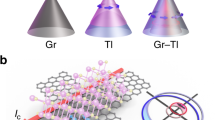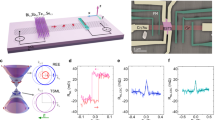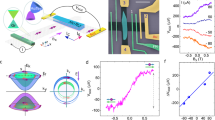Abstract
Quantum optoelectronic devices capable of isolating a target degree of freedom (DoF) from other DoFs have allowed for new applications in modern information technology. Many works on solid-state spintronics have focused on methods to disentangle the spin DoF from the charge DoF1, yet many related issues remain unresolved. Although the recent advent of atomically thin transition metal dichalcogenides (TMDs) has enabled the use of valley pseudospin as an alternative DoF2,3, it is nontrivial to separate the spin DoF from the valley DoF since the time-reversal valley DoF is intrinsically locked with the spin DoF4. Here, we demonstrate lateral TMD–graphene–topological insulator hetero-devices with the possibility of such a DoF-selective measurement. We generate the valley-locked spin DoF via a circular photogalvanic effect in an electric-double-layer WSe2 transistor. The valley-locked spin photocarriers then diffuse in a submicrometre-long graphene layer, and the spin DoF is measured separately in the topological insulator via non-local electrical detection using the characteristic spin–momentum locking. Operating at room temperature, our integrated devices exhibit a non-local spin polarization degree of higher than 0.5, providing the potential for coupled opto-spin–valleytronic applications that independently exploit the valley and spin DoFs.
This is a preview of subscription content, access via your institution
Access options
Access Nature and 54 other Nature Portfolio journals
Get Nature+, our best-value online-access subscription
$29.99 / 30 days
cancel any time
Subscribe to this journal
Receive 12 print issues and online access
$259.00 per year
only $21.58 per issue
Buy this article
- Purchase on Springer Link
- Instant access to full article PDF
Prices may be subject to local taxes which are calculated during checkout



Similar content being viewed by others
References
Žutić, I., Fabian, J. & Sarma, S. D. Spintronics: Fundamentals and applications. Rev. Mod. Phys. 76, 323–410 (2004).
Mak, K. F., Lee, C., Hone, J., Shan, J. & Heinz, T. F. Atomically thin MoS2: a new direct-gap semiconductor. Phys. Rev. Lett. 105, 136805 (2010).
Zeng, H., Dai, J., Yao, W., Xiao, D. & Cui, X. Valley polarization in MoS2 monolayers by optical pumping. Nat. Nanotech. 7, 490–493 (2012).
Xiao, D., Liu, G. B., Feng, W., Xu, X. & Yao, W. Coupled spin and valley physics in monolayers of MoS2 and other group-VI dichalcogenides. Phys. Rev. Lett. 108, 196802 (2012).
Kato, Y., Myers, R., Gossard, A. & Awschalom, D. Observation of the spin Hall effect in semiconductors. Science 306, 1910–1913 (2004).
Rokhinson, L., Pfeiffer, L. & West, K. Spontaneous spin polarization in quantum point contacts. Phys. Rev. Lett. 96, 156602 (2006).
Watson, S. K., Potok, R., Marcus, C. & Umansky, V. Experimental realization of a quantum spin pump. Phys. Rev. Lett. 91, 258301 (2003).
Ganichev, S. et al. Spin-galvanic effect. Nature 417, 153–156 (2002).
Fert, A. & Jaffres, H. Conditions for efficient spin injection from a ferromagnetic metal into a semiconductor. Phys. Rev. B 64, 184420 (2001).
Wunderlich, J. et al. Spin Hall effect transistor. Science 330, 1801–1804 (2010).
Srivastava, A. et al. Valley Zeeman effect in elementary optical excitations of monolayer WSe2. Nat. Phys. 11, 141–147 (2015).
Zhong, D. et al. Van der Waals engineering of ferromagnetic semiconductor heterostructures for spin and valleytronics. Sci. Adv. 3, e1603113 (2017).
Kim, J. et al. Ultrafast generation of pseudo-magnetic field for valley excitons in WSe2 monolayers. Science 346, 1205–1208 (2014).
Yuan, H. et al. Generation and electric control of spin–valley-coupled circular photogalvanic current in WSe2. Nat. Nanotech. 9, 851–857 (2014).
Han, W. & Kawakami, R. K. Spin relaxation in single-layer and bilayer graphene. Phys. Rev. Lett. 107, 047207 (2011).
Fu, L., Kane, C. L. & Mele, E. J. Topological insulators in three dimensions. Phys. Rev. Lett. 98, 106803 (2007).
Xia, Y. et al. Observation of a large-gap topological-insulator class with a single Dirac cone on the surface. Nat. Phys. 5, 398–402 (2009).
Ganichev, S. D. & Prettl, W. Spin photocurrents in quantum wells. J. Phys. Condens. Matter 15, R935–R983 (2003).
McIver, J. W., Hsieh, D., Steinberg, H., Jarillo-Herrero, P. & Gedik, N. Control over topological insulator photocurrents with light polarization. Nat. Nanotech. 7, 96–100 (2011).
Eginligil, M. et al. Dichroic spin-valley photocurrent in monolayer molybdenum disulphide. Nat. Commun. 6, 7636 (2015).
Yuan, H. et al. Zeeman-type spin splitting controlled by an electric field. Nat. Phys. 9, 563–569 (2013).
Duan, J. et al. Identification of helicity-dependent photocurrents from topological surface states in Bi2Se3 gated by ionic liquid. Sci. Rep. 4, 4889 (2014).
Okada, K. N. et al. Enhanced photogalvanic current in topological insulators via Fermi energy tuning. Phys. Rev. B 93, 081403(R) (2016).
Guimarães, M. et al. Controlling spin relaxation in hexagonal BN-encapsulated graphene with a transverse electric field. Phys. Rev. Lett. 113, 086602 (2014).
Heo, H. et al. Interlayer orientation-dependent light absorption and emission in monolayer semiconductor stacks. Nat. Commun. 6, 7372 (2015).
Ogawa, N., Bahramy, M. S., Kaneko, Y. & Tokura, Y. Photocontrol of Dirac electrons in a bulk Rashba semiconductor. Phys. Rev. B 90, 125122 (2014).
Bychkov, Y. A. & Rashba, E. Properties of a 2D electron gas with lifted spectral degeneracy. JETP Lett. 39, 78–81 (1984).
Zhu, C. et al. Exciton valley dynamics probed by Kerr rotation in WSe2 monolayers. Phys. Rev. B 90, 161302 (2014).
Kim, J. et al. Observation of ultralong valley lifetime in WSe2/MoS2 heterostructures. Sci. Adv. 3, e1700518 (2017).
Hao, K. et al. Direct measurement of exciton valley coherence in monolayer WSe2. Nat. Phys. 12, 677–682 (2016).
Appelbaum, I. Introduction to spin-polarized ballistic hot electron injection and detection in silicon. Phil. Trans. R. Soc. A 369, 3554–3574 (2011).
Kamalakar, M. V., Dankert, A., Bergsten, J., Ive, T. & Dash, S. P. Enhanced tunnel spin injection into graphene using chemical vapor deposited hexagonal boron nitride. Sci. Rep. 4, 6146 (2014).
Noh, H.-J. et al. Controlling the evolution of two-dimensional electron gas states at a metal/Bi2Se3 interface. Phys. Rev. B 91, 121110(R) (2015).
Acknowledgements
This work was supported by Samsung Research Funding Centre of Samsung Electronics under project number SRFC-MA1402-02.
Author information
Authors and Affiliations
Contributions
S.C. and M.N. contributed equally to this work. H.C. conceived the main idea and designed the experimental protocols. S.C., M.N., J.-H.K., J.S., H.B., D.L., H.S., S.Y., S.L., W.S., C.-H.L., M.-H.J. and D.K. performed the sample fabrication. S.C., S.S., M.N. and J.L. performed the CPGE measurements. H.K. and J.K. provided single crystal Bi2Se3. H.C. supervised the project. S.C., M.N. and H.C. wrote the manuscript with input from all authors.
Corresponding author
Ethics declarations
Competing interests
The authors declare no competing interests.
Additional information
Publisher’s note: Springer Nature remains neutral with regard to jurisdictional claims in published maps and institutional affiliations.
Supplementary information
Supplementary Information
Supplementary Figures 1–6, Supplementary Tables 1–3, Supplementary References
Rights and permissions
About this article
Cite this article
Cha, S., Noh, M., Kim, J. et al. Generation, transport and detection of valley-locked spin photocurrent in WSe2–graphene–Bi2Se3 heterostructures. Nature Nanotech 13, 910–914 (2018). https://doi.org/10.1038/s41565-018-0195-y
Received:
Accepted:
Published:
Issue Date:
DOI: https://doi.org/10.1038/s41565-018-0195-y
This article is cited by
-
Disorder-induced bulk photovoltaic effect in a centrosymmetric van der Waals material
npj 2D Materials and Applications (2023)
-
Recent developments in CVD growth and applications of 2D transition metal dichalcogenides
Frontiers of Physics (2023)
-
Polarization-controlled tunable directional spin-driven photocurrents in a magnetic metamaterial with threefold rotational symmetry
Nature Communications (2022)
-
Room-temperature valleytronic transistor
Nature Nanotechnology (2020)
-
Valleytronics in transition metal dichalcogenides materials
Nano Research (2019)



